Magnus Carlsen triumphs in first Casablanca Chess Variant Tournament
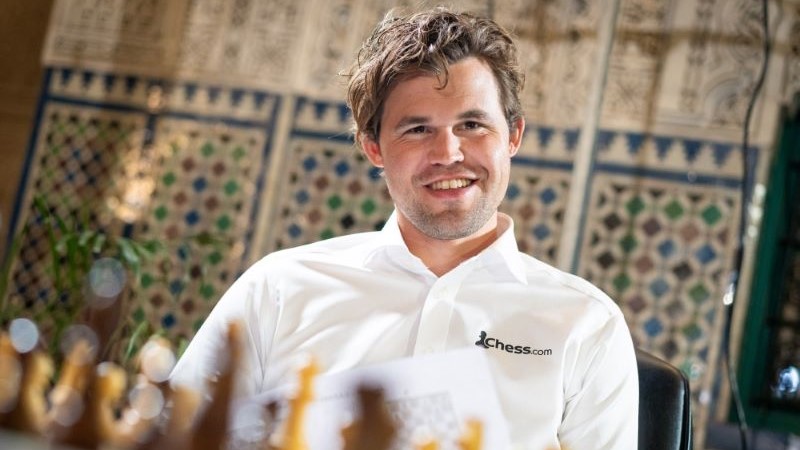
The inaugural Casablanca Chess tournament took place over the weekend of May 18-19, 2024. This unique event featured chess grandmasters Magnus Carlsen, Hikaru Nakamura, Viswanathan Anand, and Amin Bassem competing in the new “Casablanca chess variant,” a format designed to honor the history of chess. The play began from positions taken from historical games, chosen by Grandmasters Hicham Hamdouchi and Laurent Fressinet. On the second day, Magnus Carlsen, leading with 2.5 points out of 3, won another game and drew two for a final score of 4.5 out of 6. Carlsen is the winner of the first Casablanca chess variant tournament. Hikaru Nakamura finished second with 3.5 points, followed by Viswanathan Anand with 3 points and Bassem Amin with 1 point. The first game of the second day began from a position selected by Women Grandmasters Dana Reizniece-Ozola (Deputy Chair of the FIDE Management Board) and Anna Burtasova (Casablanca Chess Press Officer). The choice was between Botvinnik-Tal 1960, Alekhine-Euwe 1935, and Ju-Goryachkina 2020. Dana and Anna chose a second position, describing it as “dynamic with chances for both sides, perfect for spectators.” The original game, Game 3 from the 1935 World Championship match, was won by Alekhine in 41 moves. It derived from the double-edged Winawer Variation in the French Defense. The game continued 9.Ne2 Nbd7 10.Ng3 Rg6. Viswanathan Anand and Magnus Carlsen followed the original game for two moves before Carlsen deviated with 10…Qa5. Despite an initial advantage for White, the game soon balanced out. Carlsen found a beautiful way to force a draw by sacrificing his rook on g2. 19… Rxg2+ 20. Kxg2 Nf4+ 21. Kg1 Nh3+ 22. Kg2 Nf4+ 23. Kg1 Nh3+ ½-½ In another game, Bassem Amin, playing White against Hikaru Nakamura, deviated right away by playing 9. dxc5. The players quickly exchanged queens and reached an equal endgame. However, Nakamura gradually outplayed Amin and secured a win. Nakamura shared his thoughts after the game: “I thought that this position was actually a little bit better for White, a little easier with the two bishops; it felt like Black would have to prove the equality. I would have been much happier to play on the white side. I got a little bit lucky because my opponent tried to simplify, but the simplification was just bad, in my opinion.” The position for Round 5 was chosen by the YouTube and Twitch audience. It was a close run between Kasparov-Karpov 1987, Ushenina-Hou 2013, and Zhu-Kosteniuk 2001. The Kasparov-Karpov game won by a slight margin of 37.17% votes against Ushenina-Hou with 35.65%. The final game of the 1987 match between Kasparov and Karpov was selected. It finished in a 64-move win for Kasparov. “…someone ran into the meeting room to announce, “Karpov resigned!” It was, without question, the loudest and longest-standing ovation I had ever received outside my native country. […] I had done what Karpov had failed to do in 1985: won the final game and drawn the match to retain my title.” – wrote Garry Kasparov in “How Life Imitates Chess” (2007, Bloomsbury Publishing USA). The original game continued 9.Nc3 Ne4 10.Ne2 a5 11.d3 Bf6 12.Qc2 Bxb2 13.Qxb2 Nd6. Both Hikaru Nakamura, with White against Viswanathan Anand, and Magnus Carlsen, with White against Bassem Amin, chose 9. Qe2. Both Nakamura and Carlsen went for a plan of extending their kingside pawns, but with different effects: Nakamura-Anand ended in a draw, whereas Carlsen gained the upper hand against Amin. Going into the final round, Carlsen was in the lead with 4 points, followed by Nakamura with 3. The American player needed only a win with Black against the leader to force a playoff for first. The players chose the starting position for the final game from the three options from women’s games: Graf-Menchik 1934, Gaprindashvili-Alexandria 1975, and Xie-Galliamova 1999. All players except Amin chose the third one, and so they had to start the games from move 15 in Game 2 of the 1999 Women’s World Championship. The original game continued with immediate assault on the kingside: 15.g4 fxg4 16.h3 gxh3 17.Bxh3 Qc7 18.f5 O-O-O. Anand opted for 15. Ne2, following up with g4 a move later. He capitalized on Amin’s blunder on move 23 and quickly converted his advantage to a win. Magnus Carlsen repeated the original game, deviating on move 18 with 18. Qg1. On the 24th move, Carlsen got a great position after adventurous 24… Qf2 from Nakamura. However, on move 27, the Norwegian did not find the best continuation, giving away the advantage with 27. Rh8. After that, the game quickly ended with a repetition, making Carlsen the winner of the tournament. Magnus Carlsen expressed his enjoyment of the innovative format: “It was a fun format for sure, I would definitely like to try it again. With one exception in game two, all the positions were very rich with lots of play. It doesn’t really matter if you are playing White or Black, because you know that the position is equal and there are chances for both sides. It is also a lot of fun to end up in positions that I don’t play too often. I enjoyed it a lot.” At the closing ceremony, Tarik Senhaji, the CEO of the Casablanca Stock Exchange, said that the organizers of the Morocco Chess Week were very grateful for the High Patronage of His Majesty King Mohammed VI. Senhaji expressed his gratitude to the event’s organizers and partners. These included the Casablanca Stock Exchange, Casablanca Events & Animation, the International Chess Federation, and the Royal Moroccan Chess Federation. He extended his heartfelt thanks to all those who worked tirelessly to ensure the event’s success. He also acknowledged the local chess enthusiasts whose daily presence and enthusiasm added to the vibrancy of the venue. Tarik Senhaji was joined on the stage by Dana Reizniece-Ozola (Deputy Chair of FIDE Management Board), Bouchra Kadiri (President of the Provisional Committee in charge of the Moroccan Royal Chess Federation), and the “board masters” Hicham Hamdouchi and Laurent Fressinet who selected the historical positions. As the audience erupted in applause, the players were presented with their well-deserved awards. Nakamura, Anand, and Amin each received traditional cups. Magnus Carlsen, the winner, was bestowed with a sophisticated trophy shaped like a knight. Photos
FIDE 100 celebrations reach Morocco
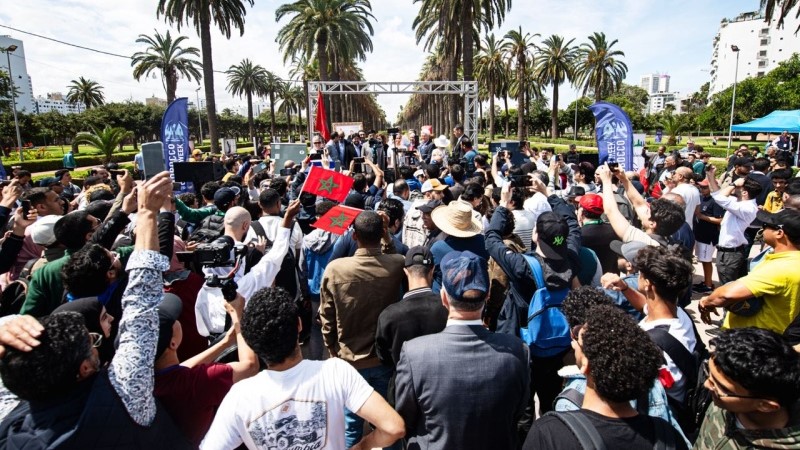
The centenary celebrations of the International Chess Federation are unfolding across the globe, and sunny Casablanca in Morocco has been chosen as the African host city for this momentous occasion. On Saturday, May 18, a significant event took place at the Parc de la Ligue Arabe in the heart of Casablanca. During the opening ceremony of Morocco Chess Week, FIDE President Arkady Dvorkovich delivered a speech emphasizing the historical significance of the celebration: “It’s not just an event; it’s one of the central elements of our 100-year anniversary celebration this year. We are looking at our history. We started in India, where chess was most likely born; we went to Switzerland, where, for many years, FIDE headquarters has been located, and now we are in Morocco, where chess most likely came to Europe. It’s about our roots.” The festivities commenced with the Chess Olympiad Torch Relay. The torch’s journey began in India, where the 44th Chess Olympiad took place in 2022. From there, it traveled to Ghana, Switzerland, Canada and finally arrived in Morocco. The enthusiastic crowd of chess fans gathered in the park, welcomed by live traditional Moroccan music performed by expressive musicians. FIDE officials graced the stage, with FIDE President Arkady Dvorkovich, Deputy Chair of Management Board Dana Reizniece-Ozola, and Continental President for Africa Tshepiso Lopang, among other distinguished guests. The audience erupted with excitement as grandmasters Hikaru Nakamura, Viswanathan Anand (FIDE Deputy President), and local hero, 7-time African champion Bassem Amin made their appearances. Later that day, Magnus Carlsen joined them in a rapid tournament, showcasing the innovative Casablanca chess variant. “Welcome to Morocco, welcome to Africa, and welcome to the Arab world!” exclaimed the ceremony’s host. The anthems of Morocco and FIDE were played. FIDE President delivered an inspired speech, finishing with words that caused great applause: “This celebration highlights the importance of Morocco and Casablanca in the chess world. It demonstrates our commitment to advancing the game and underscores our unity. The game is just beginning—another century for chess!” “To be honest, I’ve never seen such enthusiasm for chess. To see all the people who are out here today…” the words of Hikaru Nakamura were drowned in cheering from the crowd. “…I hope it will inspire you to play more chess and enjoy everything about the game!” Anand and Nakamura’s speeches ignited chants of “Bassem! Bassem! Bassem!” in honor of the African hero, who addressed the audience in Arabic. The torch relay continues, with upcoming stops in Colombia and Kazakhstan. The flame was passed to Darmen Sadvakasov, 1st Vice-President of the Kazakhstan Federation, and Executive Director Gulmira Dauletova. Following the torch ceremony, a massive 100-player simultaneous exhibition unfolded in one of the park’s shadowy alleys. The local talents were tested by IM Mohamed Tissir, GM Laurent Fressinet, GM Alexander Volzhin, WGM Atousa Pourkashiyan, WGM Gulmira Dauletova, WGM Dana Reizniece-Ozola, Nadezhda Marochkina, WIM Tshepiso Lopang, Benard Wanjala, and GM Bashar Kouatly; each of them faced ten opponents. The simul lasted for several hours, with some participants securing draws or even wins against the seasoned players. In another alley of the park, attendees admired brilliant photographs by Stev Bonhage. His exhibition, titled “Capture,” travels the world, showcasing the art of chess and photography. The pictures feature professional chess players, random strangers, the elderly, and children—all united by their love for the game. After the exciting day under the sun, the public and distinguished guests moved to the beautiful Mechouar Palace to watch Carlsen, Nakamura, Anand, and Amin battle in the Casablanca Chess rapid tournament. Written by Anna Burtasova, Casablanca Chess Press Officer Photos: Stev Bonhage
Casablanca Chess: Carlsen takes the lead on Day 1
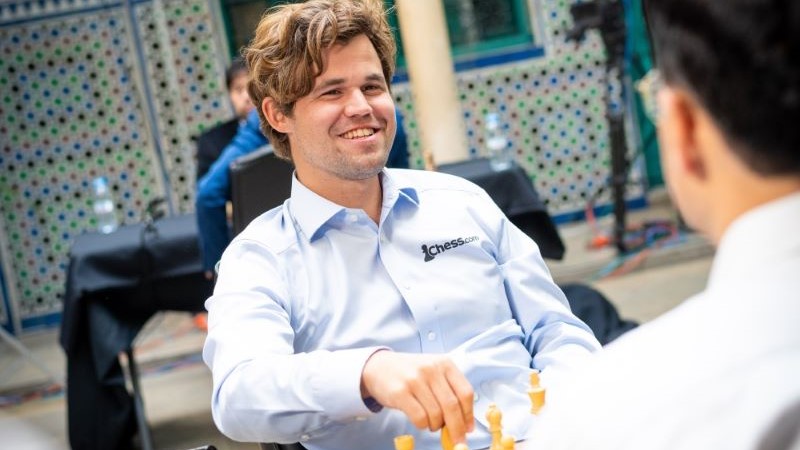
Casablanca Chess made a strong impression on the first day of play in Morocco. The innovative format, where players begin in positions selected from historical games, brought excitement to both participants and spectators. Following three rounds and six rapid games Magnus Carlsen is leading with 2.5 points (wins against Anand and Nakamura, a draw with Amin). Hikaru Nakamura is in second place with 1.5 points (a win against Amin, a draw with Anand, and a loss from Carlsen). Viswanathan Anand and Bassem Amin both find themselves at the bottom of the tournament table with 1 point each (two draws and one loss). The first-round position was selected by the broadcast commentators, grandmasters Jan Gustafsson and Daniel Naroditsky. They had three options: Chigorin-Steinitz 1889, Lasker-Tarrasch 1908, and Rubtsova-Bykova 1958. “Just for pure excitement, we have to go with number 1,” said Gustafsson. “That’s an Evans Gambit, a 19th-century style!” Naroditsky chimed in. This is how the players transported themselves back to 1889, revisiting a World Championship match in Havana. They began from the 11th move, a departure from Wilhelm Steinitz’s original 11. dxe5 – a move that none of our participants replicated. Magnus Carlsen opted for 11. Na3. A few moves later, Viswanathan Anand took a daring path with his queen, only to find it trapped shortly afterward. White secured victory in just 20 moves. Hikaru Nakamura, with White against Bassem Amin, started with a solid 11. Bf1 but very soon sacrificed both rooks, gaining a queen in return and achieving a winning position. The American wrapped it up with a nice bishop sacrifice. 24. Bf6! h6 (24…fxf6 25. exf6 Bb4 26. Bd3) 25. Qf4 Bb4 26. Bd3 d5 27. Bxg7 Kxg7 28. Qf6+ 1-0 This game lasted a little longer, White won too, putting Carlsen and Nakamura in an early lead. Bassem commented, “The starting position may appear equal, but as Black, you’re on the defensive side, and one wrong move can destroy everything.” Offering his thoughts, Anand said, “I liked the idea [of the Casablanca chess variant], but I haven’t given it much thought; it just seemed like something fun. The position from the first game is challenging to grasp in rapid play. And having only two minutes before the start is very little to think of anything. It feels like being thrown into the deep end every time. Let’s see if it gets better!” For the second round, the players themselves voted on the position. The options were Graf-Menchik 1934, Xie-Galliamova 1999, and Smyslov-Botvinnik 1957. Not knowingly, Anand, Nakamura, and Bassem all chose different ones, so it was ultimately Carlsen’s decision that sealed the deal. The players began their game at move 11 in Game 10 of the Xie Jun vs. Alisa Galliamova Women’s World Championship Match in Kazan/Shenyang in 1999. In the original game, Xie chose 11. Be3. Bassem, playing White against Carlsen, followed a similar path. The players continued the game until move 19 when Carlsen deviated by playing 19… Rc8 instead of Galliamova’s 19… Re4. In the ensuing rook endgame, Carlsen managed to win a pawn, but it still resulted in an easy draw for White. The game concluded uneventfully on move 46. Anand also selected 11. Be3, but in this game, Nakamura (playing as Black) deviated earlier. At move 15, Nakamura opted for an intermediate move, 15… Bc5, rather than 15… Bf6.The game quickly transitioned into a drawish rook endgame, and the players split the point on move 49 through a threefold repetition. Notably, players are not allowed to offer a draw at any moment during the game. The third position was determined by a popular vote during the broadcast. The audience had to choose between three famous world championship matches: Alekhine vs. Capablanca (1927), Spassky vs. Fischer (1972), and Karpov vs. Kasparov (1985). Ultimately, they opted for the latter. Bassem vs Anand and Nakamura vs Carlsen started from move 12 in the 14th game of the 1985 Karpov-Kasparov match. The players followed the original game with 12. Nd5 Rc8 and 13. c3. However, Anand deviated by capturing a pawn on h4 (13… Bxh4), digressing from the predecessors, and the game finished in a draw by repetition just a couple of moves later. Carlsen, on the other hand, adhered to the original game with 13… Nf6 but then made an unorthodox move on the next turn, playing 14…Kxe7 instead of Kasparov’s 14…Qxe7. After 15. g5 Ng4 16. Bc1 hxg5 Hikaru made a serious mistake with 17. Bf3? (17. f3 Nf6 18. Bxg5 and White is fine). Magnus quickly gained an advantage with 17…Qd7! 18. Rg1 Nh2 19. Bg5+ f6 and won the game on move 35. After the day was over, Carlsen shared his impressions: “It’s a fun format. I think what happened in the second game was a bit of a shame as it all liquidated to a draw pretty quickly.” Answering whether he recognized any of the starting positions, Carlsen replied: “The last game looked very similar to Karpov-Kasparov games from the second match, and I seemed to remember that Garry’s knight ended up on g4 and maybe h2. But that was about it. The first game I thought it has to be a Steinitz game since he’s the only one who plays like that. Probably against Chigorin, as they had a World Championship match in 1889, and there were a lot of Evans gambits. The second one, I had no clue!” The play will resume on Sunday, May 19, with three more rounds. Photos (please attribute the photographer when using): DropboxLive Broadcast: Casablanca Chess 2024 – Chess.comOfficial Website: Casablanca-Chess Written by Anna Burtasova, Casablanca Chess Press Officer Photos by Lennart Ootes
Morocco Chess Week kicks off in Casablanca

The 2024 edition of Morocco Chess Week started in Casablanca with the official Opening Ceremony at the Casablanca Stock Exchange. The event is held under the High Patronage of His Majesty King Mohammed VI. Since its launch in 2021, initiated by Casablanca Events & Animation and the Casablanca Stock Exchange, this festival has grown to an international scale. The 3rd edition of the festival is organized in partnership with the Royal Moroccan Chess Federation. The main attraction is the Casablanca Chess Tournament, featuring Magnus Carlsen, Hikaru Nakamura, Viswanathan Anand, and Amin Bassem. They will try out the novel “Casablanca chess variant” designed to celebrate the history of chess. The grandmasters will start their rapid games from positions derived from historical games carefully selected by GMs Hicham Hamdouchi and Laurent Fressinet. The idea of this innovative format was suggested by Tarik Senhaji, CEO of Casablanca Stock Exchange. This tournament promises a unique experience, honoring the rich history of the game. The games start on May 18 at 16:15 local time. Live Broadcast: Casablanca Chess 2024 – Chess.com The Opening Ceremony began with a speech by Mr Tarik Senhaji, CEO of the Casablanca Stock Exchange. He said: “This festival, from the start, has been more than just a competition for us organizers; it has been a celebration of the spirit of chess. It is about learning, sharing, and growing together as a community. It is about fostering the values of chess for the wider community and fulfilling our social values for us at Bourse de Casablanca and also our partners.” Mr Chakib Benmoussa, Minister of National Education, Preschool Learning and Sports, took the stage next. He emphasized that chess is not only a sport and a cultural phenomenon but also a great educational tool. This year marks the centenary of the International Chess Federation, and Casablanca has been selected as the African city for the festivities. This celebration will feature the Chess Olympiad Torch Relay, which travels around the world leading up to Budapest, where the Chess Olympiad will be held in September. On this occasion, a significant event will be organized at the Parc de la Ligue Arabe with several enriching activities for the general public, including a simultaneous exhibition with 100 players. Arkady Dvorkovich, FIDE President, said in his speech: “It’s not just an event, it’s one of the central elements of our 100-year anniversary celebration this year. We are looking at our history. We started in India, where most likely chess was born, we went to Switzerland, where for many years FIDE headquarters has been located, and now we are in Morocco from where most likely chess came to Europe. It’s about our roots.” On the occasion of FIDE anniversary, FIDE President awarded the FIDE Medal of Merit to Mr Chakib Benmoussa, recognizing his contribution to the development of chess in the region. The Opening Ceremony speeches continued with addresses from Mrs Tshepiso Lopang, President of the African Chess Confederation, Mr Mohamed Jouahri, CEO of Casablanca Events and Animation, and Mrs Bouchra Kadiri, President of the Provisional Committee in charge of the Moroccan Royal Chess Federation. In the end, the distinguished guests rang the ceremonial bell, officially opening the Morocco Chess Week 2024. Replay of the Opening Ceremony livestream: YouTubePhotos (please attribute the photographer when using): DropboxLive Broadcast: Casablanca Chess 2024 – Chess.comOfficial Website: Casablanca-Chess Written by Anna Burtasova, Casablanca Chess Press Officer Photos by Lennart Ootes
Freedom Holding Corp. to Be Title Sponsor of Landmark Chess Event in New York City

Bringing the Brightest Stars in Chess from the Global Business Community Together for an Ultimate Chess Challenge Freedom Holding Corp. (NASDAQ: FRHC), a multi-national diversified financial services holding company, today announced its participation as a competitor and as the title sponsor of the landmark chess event, the 2024 FIDE World Corporate Chess Championship. Hosted by the International Chess Federation (FIDE), this three-day championship event will showcase the brightest stars in business and some of the biggest names in chess. Since the beginning of March, registered corporate teams have been competing online to qualify to participate in this elite battle for the title of Smartest Company in the World. And for the first time since the pandemic, the tournament will be an in-person, over-the-board experience, held from June 15 -17, 2024, in the heart of New York City’s financial district in the historic Cunard building. The Smartest Companies Know… “The game of chess knows no borders and sets aside all politics,” said Timur Turlov, Freedom Holding Corp.’s Chairman and Chief Executive Officer. “Success in chess, like business, comes from thoughtful deliberation and strategic positioning. This partnership is a true reflection of Freedom and our approach to business – well-researched, collaborative, and intentional. We are delighted to be competing in, as well as being the presenting sponsor of, the FIDE World Corporate Chess Championship. We’ve invited leaders in business from across the globe to join the challenge,” the CEO noted. 100 Years of Making Chess History… Arkady Dvorkovich, president of FIDE, commented, “This year marks the 100th anniversary of FIDE; our organization has a longstanding, rich history of building community and fostering growth and camaraderie among players and across continents. Hosting this event in partnership with the Freedom Holding Corp. team is the perfect way to mark this momentous celebration. A world-class event, presented by a world-class leader in business, at a world-class location, to continue supporting global unity through a common language and passion for chess.” Sponsorship: Make the Right Move for Your Organization… Registration to compete has now closed. However, sponsorship opportunities remain available. VIP packages will include global brand awareness campaigns, meet and greet opportunities with the elite of chess and business, and so much more. For more information about sponsorships please contact, Ekaterina.Mashina@FIDE.com. Get Your Tickets Now… The countdown is on, and space is limited. Tickets go on sale May 20, 2024, at 12:00 p.m. ET, at freedomcapmkts.com/chess About Freedom Holding Corp. Freedom Holding Corp. is a diversified financial services holding company conducting retail securities brokerage, securities dealing, market making, investment research, investment counseling, investment banking and underwriting services, consumer banking, insurance and several ancillary businesses which complement its core financial services businesses, through its subsidiaries, under the name Freedom Finance in Europe and Central Asia, and Freedom Capital Markets in the United States. Through its subsidiaries, Freedom Holding Corp. employs more than 6,000 people and is a professional participant in the Kazakhstan Stock Exchange, the Astana International Exchange, the Republican Stock Exchange of Tashkent, and the Uzbek Republican Currency Exchange and is a member of the New York Stock Exchange and the Nasdaq Stock Exchange. Freedom Holding Corp. is headquartered in Almaty, Kazakhstan, and has operations and subsidiaries in 19 countries, including Kazakhstan, the United States, Cyprus, Poland, Spain, Uzbekistan, and Azerbaijan, among others. Freedom Holding Corp.’s common shares are registered with the United States Securities and Exchange Commission and are traded under the symbol FRHC on the Nasdaq Capital Market, operated by Nasdaq, Inc. To learn more about Freedom Holding Corp., visit freedomholdingcorp.com About FIDE The International Chess Federation (FIDE) is the governing body of the sport of chess, and it regulates all international chess competitions. Constituted as a non-governmental institution, it was recognized by the International Olympic Committee as a Global Sporting Organization in 1999. FIDE currently has its headquarters in Lausanne, but it was initially founded in 1924 in Paris under the motto “Gens una Sumus” (Latin for “We are one Family”). It was one of the very first International Sports Federations, alongside the governing bodies of the sports of football, cricket, swimming, and auto racing. It is now one of the largest, encompassing 201 countries as affiliate members, in the form of National Chess Federations. Chess is nowadays a truly global sport, with dozens of millions of players in all the continents, and more than 60 million games on average played every day.
Guinness World Records Attempt: Registration of tournaments open
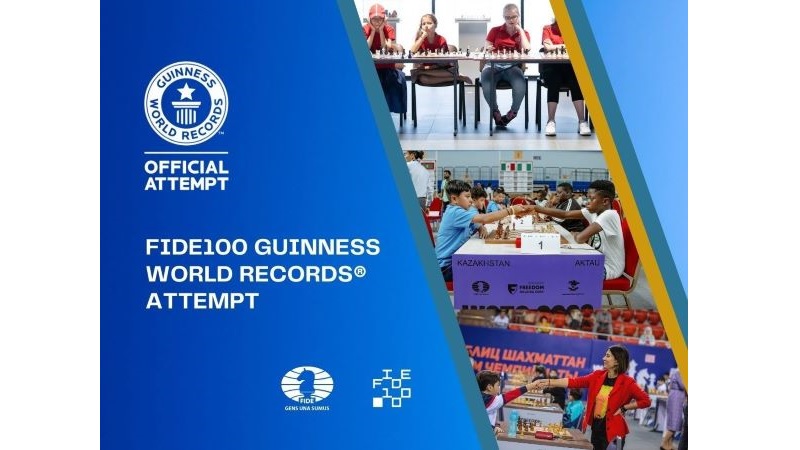
On July 20, 2024, the International Chess Day, FIDE celebrates its centenary anniversary. To mark this date, we aim to set the Guinness World Record for the most chess games played within 24 hours, both online and over-the-board. FIDE invites federations, chess organizers and clubs to join the attempt and help us set a new milestone for the chess world! Be a part of the biggest chess day of all time! You can participate in the Guinness World Records attempt from any corner of the globe. Requirements for tournaments to join the Guinness World Records Attempt: 1. To be eligible, tournaments must meet to the following criteria: Held between July 20, 2024 00:00:00 CEST and July 21, 2024 00:00:00 CEST; a single round of a several day event, played on July 20, is also compliant with the attempt; Supervised by a FIDE licensed arbiter; Registered on the official website of the Guinness World Records Attempt before July 15; Eligible formats: OTB: Swiss system, round-robin, or simultaneous display tournament; Online: Swiss system or round-robin tournaments, arena or individual ‘online rated’ games, with a minimum number of 15 moves. 2. Game requirements are the following: Games must adhere to the Laws of Chess with specific time controls and formats; Minimum 3 min. + 2 sec. increment per move, starting from move 1 (for games with increment) or 5 min. per game (for games without increment); Maximum duration: 8 hours; All games need to start and finish within the designated 24 hours to count. 3. Submitting Results: The event supervisor/FIDE licensed arbiter needs to confirm the number of games played, provide to FIDE a standard TRF file and sign a protocol confirming the number of games played; The registration of the tournaments participating in the GUINNESS WORLD RECORDS Attempt is available via the official FIDE Guinness World Record Attempt page. Registration deadline: July 15, 2024 About the Guinness World Records Guinness World Records, originally known as the Guinness Book of Records, has emerged as the definitive authority on record-breaking achievements, stemming from the idea of resolving disputes in pubs with a book of facts. Today, it stands as a global brand, with offices spanning London, New York, Beijing, Tokyo, and Dubai, alongside a network of brand ambassadors worldwide. Its mission extends beyond the pages of its iconic book, now encompassing TV shows, social media, and live events, all aimed at documenting the extraordinary.
FIDE International Chess Day Art Contest announced

The International Chess Federation (FIDE) is thrilled to announce an exciting art contest dedicated to celebrating International Chess Day on July 20. This year, in conjunction with the festivities, we are aiming to set a Guinness World Record attempt for the most chess games played within 24 hours, both online and over the board, with licensed arbiters present. To commemorate this historic event, we invite artists from around the globe to participate in our art contest by creating captivating posters that inspire communities to join us in this remarkable celebration of chess. As we are celebrating the Centenary of the International Chess Federation this year, we are also inviting creative works with the theme “FIDE 100”. Contest Categories: AI Artwork: This category is open to submissions created using artificial intelligence (AI) tools or algorithms. Traditional Artwork: This category is open to submissions created by traditional means, such as drawing or painting. Theme 1: Artwork submissions should focus on promoting and encouraging communities to participate in the Guinness World Record attempt for the most chess games played within 24 hours, emphasizing the excitement and universality of chess as a game that brings people together. Theme 2: Artworks should be created to reflect some of the important chess events that happened in the last 100 years. The artist must reflect on FIDE’s influence in the shaping of the world of chess since 1924. Regulations: Eligibility: The contest is open to artists of all ages and skill levels worldwide. Participants may enter in one or both categories. All submissions must be original works created specifically for this contest. Submission Guidelines: The artwork resolution should be at least 5 megapixels, ideally around 15 megapixels, and the file size should be less than 5MB. Submissions must be in raster image file format (JPEG, PNG, GIF, TIFF) For the Traditional Artwork category, Submissions must be scanned or photographed and submitted in the image file format described above. Each participant may submit only one entry per category. Content Guidelines: Designs should be visually striking and easily understandable, with a clear message encouraging participation. Any text included in the artwork must be in English. Theme 1: The artwork should incorporate the contest theme and prominently feature the date (July 20th) and the event details. Submission Process: Participants must submit their entries via 100.fide.com/fide-international-chess-day-art-contest/ and fill in the application form there. Deadline: The deadline for submissions is July 10th. Judging Criteria: Creativity and originality; Relevance to the theme; Visual impact and aesthetics; Overall composition and design. Prizes: Winners will be announced during the Chess Olympiad in Budapest. Winners will receive a special appreciation certificate from FIDE President; Cash prizes will be awarded for the three best artworks. 1st place: €800, 2nd place: €500, 3rd place:€300. Winning artworks will be printed and displayed at the Olympiad venue. By participating in this contest, artists grant FIDE the right to reproduce, distribute, and display their artwork for promotional purposes related to the International Chess Day celebration, the Guinness World Record attempt, and the FIDE 100 Centenary. Join us in commemorating International Chess Day and FIDE 100 Centenary in style and helping us make history in the world of chess! We look forward to seeing your creative interpretations of this momentous occasion.
Back to the Future with Casablanca Chess!
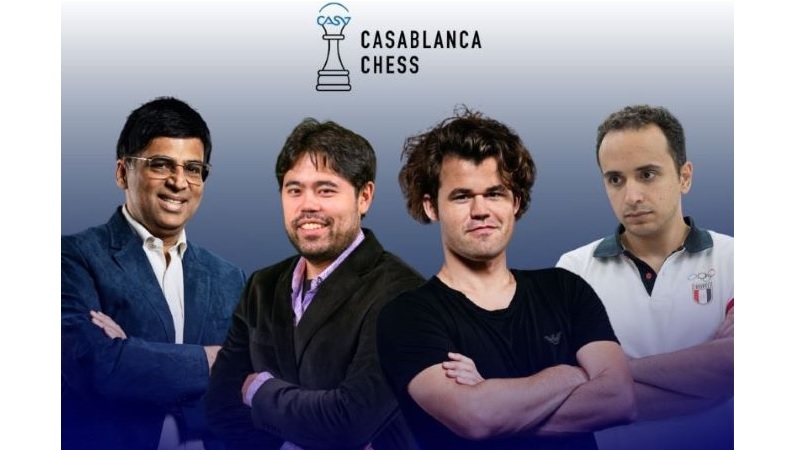
By GM Hicham Hamdouchi and GM Laurent Fressinet This weekend, the grand chess spectacle will begin in Morocco. Four top grandmasters – Carlsen, Nakamura, Anand, and Amin – will test the new Casablanca Chess Variant, introduced by the Casablanca Stock Exchange. They will start their rapid games from carefully selected positions derived from historical games. The idea of this innovative format was suggested by Tarik Senhaji, CEO of Casablanca Stock Exchange. The schedule will be as follows (all times are local): Saturday, May 18 Round 1 at 4:15 pm / Carlsen vs Anand & Nakamura vs AminRound 2 at 5:30 pm / Amin vs Carlsen & Anand vs NakamuraRound 3 at 6:45 pm / Nakamura vs Carlsen & Amin vs Anand Sunday, May 19 Round 4 at 7:15 pm / Anand vs Carlsen & Amin vs NakamuraRound 5 at 8:30 pm / Carlsen vs Amin & Nakamura vs AnandRound 6 at 9:45 pm / Carlsen vs Nakamura & Anand vs Amin The event will be broadcast live on chess.com. Each round will be preceded by a 15-minute segment dedicated to the selection of the position, either with a guest or via online polls. At the beginning of each round, the players will receive the scoresheets of the chosen position. They will have two minutes to play through the historical game on the board up to the position from which their game will commence. Subsequently, the arbiter will initiate the clocks. The time control will be 15 minutes with a 10-second increment. No draw offers will be permitted. Context There have already been themed tournaments in history, for example, starting with a position from the Buenos Aires or Najdorf variation. Alternative formats have been attempted, such as Bobby Fischer’s Chess960, Anti Chess, Crazy House, or even No Castling in Dortmund (where castling is prohibited). The objective is always the same: to break away from the well-trodden path and offer new horizons to players. Among these, only Chess960 resembles “real chess” in terms of traditional rules and enjoys relative success. The most recent experience to date was the Weissenhaus tournament in Germany, which brought together the world’s top players at classical time controls. It saw Carlsen’s victory. Unanimously, the invited top GMs were delighted with this format. It is true that Chess960 allows for more creativity. Players find themselves immediately in unfamiliar territory and try, not without difficulty, to fall back on classic and familiar patterns. The Casablanca Variant Now, let’s delve into the technical aspects of the Casablanca Variant. The idea is quite different. We stay within the realm of classical chess. Players are given a position from a game that has already been played (or could also be imagined). However, this position must meet several well-defined criteria. First and foremost, the evaluation should be roughly equal (around 0.00, according to engines). The position must be taken from the opening, somewhere between the 6th and 15th moves (although mainly between the 10th and 12th). Most importantly, and this is the most crucial criterion, it must offer rich possibilities for both players. As you may have guessed, the main idea is to have exciting games or, at the very least, encourage the participants to produce them. We will have the opportunity and privilege of having a royal line-up to test this idea (Magnus Carlsen, Hikaru Nakamura, Viswanathan Anand, and Bassem Amin). The positions will be carefully chosen by us (GM Hicham Hamdouchi and GM Laurent Fressinet). The event coincides with the centenary celebrations of FIDE. To further engage the audience, each position will be chosen from a historically significant game. Let’s look at a concrete example: Will Magnus Carlsen choose 14…Rc8? This game was played between Nona Gaprindashvili and Maia Chiburdanidze during their Women’s World Championship match in 1978. It is the 14th round, and the position arises from a Caro-Kann defence after the White’s fourteenth move 14.Rh4. The analysis module sanctions it with an even evaluation 0.00. The most played moves for Black in the database are in the following order: 14…Be7, 14…Rc8, 14…cxd4, and 14…0-0-0. Which strategy to choose? We can easily deduce that the position is rich in possibilities for both sides. We can see the potential opposite-side castling, a white pawn majority on the queenside, as well as other likely imbalances depending on the chosen plan by both sides. In the actual game, Maia chose 14…Rc8. The players quickly transitioned into an endgame in which Black missed a win, settling for a draw on the move 52. One game later, Maia Chiburdanidze was crowned world champion! No preparation possible, unless… It is in this state of mind that we have chosen a total of 18 positions (6×3=18). Before the start of every round, the position players will face off and will be picked out of possible three. After each game, it will be interesting to test the memory and encyclopaedic knowledge of our champions to see if they have managed to place the games: who played them, and when? We hope to witness a grand spectacle despite starting positions presumed to be “equal”. However, rephrasing a well-known expression: all positions are equal, but some are more equal than others!
8th YCCC: Inspiring the next generation of chess composers
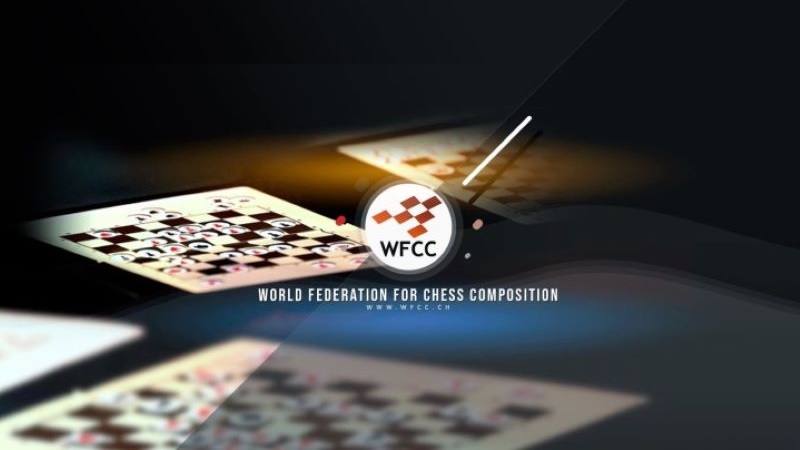
The 8th Youth Chess Composing Challenge is on the way! The youngest contributors to chess art (born 2001 and younger) were offered three different sections to inspire their creations till June 10, with five special prizes of 500 Euros vouchers each for the best representatives of the five most successful countries. The vouchers donated by the Fujairah government will be used for development of young talents, helping them to take part in the main WFCC events 2025: World Congress of Chess Composition, World Chess Solving Championship or European Chess Solving Championship. The results of the 8th YCCC will be announced on August 2, 2024, at the closing ceremony of the World Congress of Chess Composition in Jurmala. The tradition of YCCC was established in 2016 to stimulate young minds and to mentor their work. In 2024 not less than 12 well known experts in the field (FIDE grandmasters, international masters and masters of chess composition) will be engaged to comment and evaluate creations of young participants from all around the world. There are three sections: one with the set thematic condition, and two without any restrictions. The Section A is for original problems in 2 moves, with three adjacent black pawns in the same rank and the black King at least three ranks below them. In the solution, each black pawn should move and allow a different mate by White. Why was this unusual condition proposed? The primary goal is to invent something original, as a composer has to avoid repeating the same or very similar content his predecessors have created over more than 170 years of development of the orthodox #2. Searching through the databases is difficult, even for experienced composers. That’s why a very rarely explored pattern was selected. To find such a pattern the Albrecht collection was used. The largest database for two-movers was founded by the late Herman Albrecht (on paper cards) and later extended by Hans-Dieter Leiss to classify around 85.000 #2s. Next, the huge voluntary work was done by the GM Composer Udo Degener to make the collection almost three times bigger, to digitalize it and make it a free online database! At the moment, the Albrecht collection with almost 300,000 #2s by more than 15,000 composers, contains only five examples of the YCCC-8 thematic condition. All of them are presented and explained in the 8th YCCC Announcement, so there is plenty of room for originality. The five discovered examples present only three different locations of the black King (in relation to the pawns) out of 28 possible ones. It means that any presentation of the theme in remaining 25 matrices may be treated as a new record! The main task for young composers will be to present maximal activity of black pawns (three variations with different mates in the solution are thematic minimum). When the numbers of variations are approximately equal, the tireless YCCC Judge David Shire will value other artistic and constructive features. We present here one of the five examples, showing an unusual artistic approach. The author wanted and managed to present the pawns-only play. The 1st move of White, the threat, the defences and mates are all executed by pawns! №1 Albert Servais Problem 1954 (v) Mate in 2 moves There is an eternal discussion if composing chess problems helps improving skills in any other activity. First of all, it improves solving skills to help better understand the internal structure of chess problems. Ural Khasanov (pictured below, born 2006) is currently the 4th solver in the world and the youngest one among the Top 40. His meteoric rise began in 2021, together with his first big successes in YCCC. Photo: Fujairah Chess & Culture Club The thematic condition in the Section A of the 5th YCCC was to have all four Bishops in the corners in the initial position, and to use them in an intensive and interesting way. Ural managed to present four thematic tries activating all four Bishops. More than that, all four threats from the try play reappear as mates in the solution: №2 Ural Khasanov, 1st Place YCCC-5 Section A, 2021 Mate in 2 moves Later on, this #2 was included into the FIDE Album 2019-21, where the best compositions in 3-years cycles were selected. Getting into FIDE Album at the age of 15 is an historical achievement, but it didn’t break the record. For three years this record was held by the author of another YCCC success: №3 Ilija Serafimović, 1st Place YCCC-3 Section B, 2018 White to play and draw In 2018 the endgame section of the 3rd YCCC asked for original endgames presenting sacrifice of white Queen (without capturing). The winning entry included two such sacrifices into interesting play of both sides, and rewarded the 14-years author Ilija Serafimović (pictured below, born 2004) with his first FIDE Album entry! Photo: Fujairah Chess & Culture Club Ilija is the most successful participant of the previous seven YCCCs. His starting interest was composing, but from 2018 on he understood he could solve very well, and is now among the best junior solvers in the world. In fact, the best solvers among juniors show the same tendency: 8 out of the Top 10, lead by the reigning World champion Danila Pavlov (pictured below) have got a composing experience in YCCC. Photo: Fujairah Chess & Culture Club Are there composers among the young chess grandmasters? You might have heard Rameshbabu Praggnanandhaa quoting Oleg Pervakov, the multiple world champion in composing endgames, to be his favourite chess writer, but you probably didn’t know Pragg was also composing helpmates. His compatriot GM Karthikeyan Murali, known for fierce attacks, was taking part in YCCC too, again with helpmates. In general, Indian chess prodigies have wider chess composition culture than the younger generations from other countries. Photo: Eric Rosen And, who is currently the youngest chess composer ever to get in the FIDE Album book? In the year 2019, at the time of becoming the youngest (at that time) International Master in the history of American chess, the current Grandmaster Christopher Woojin Yoo (pictured above, born 19th December 2006) broke another record. He was 12 years and 7 months at the time of sending
Updated FIDE (Dutch) System Effective from July 1, 2025

The SPP Department of the Technical Commission is pleased to announce the approved updates to the C.04.3 FIDE (Dutch) System (handbook.fide.com/chapter/C0403202507). These amendments aim to simplify and enhance the end-of-round pairing process and introduce various types of Pairing Allocated Byes (PABs). Key changes include streamlining the pairing process, excluding players with fewer games from PAB candidacy, and exploring different solutions for PAB in the early rounds, such as half-point, virtual, and zero-point PABs, as well as other variable PAB solutions and considerations for full-point byes. The update draws on insights from the current FIDE (Dutch) System and the new Dubov System, indicating that some existing rules could be simplified for clarity, while a more comprehensive review could necessitate a new pairing system. We also want to draw your attention to C.04.2 General handling rules for Swiss Tournaments, C.04.4 Other FIDE-approved Pairing Systems, and C.04.5 FIDE-approved Accelerated Systems, which contain the documentation with the new references used in C.04.3 FIDE (Dutch) System. We extend our sincere appreciation to Mr. Roberto Ricca and the entire SPP Department for their dedicated efforts in refining the tie-break rules and their explanations. For any inquiries or further information, please contact Hendrik du Toit at secretary.tec@fide.com.

